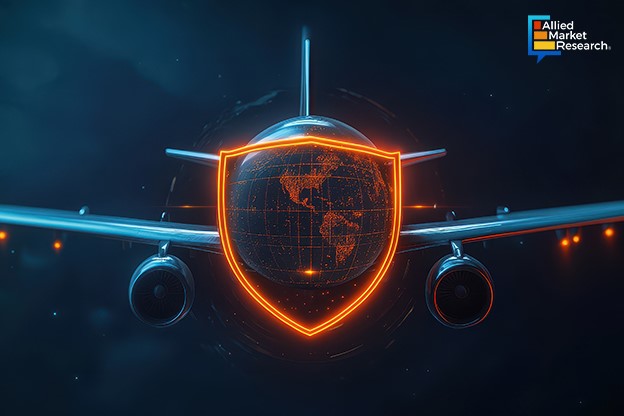Impact of Artificial Intelligence in Enhancing Cybersecurity Measures within the Aerospace Industry

24 Dec
2024
Highlights:
- Introduction
- Real-time threat detection and predictive intelligence
- Automating routine security tasks and improving threat attribution
- Enhancing aviation safety for protecting data
The aerospace industry is particularly vulnerable to cyber threats due to its reliance on highly interconnected systems. Commercial airlines, satellite operators, defense contractors, and manufacturers depend on networks that integrate communication systems. These networks support everything from navigation and air traffic control to communications between aircraft and ground stations. A cyberattack targeting any of these systems has devastating consequences, ranging from financial losses to catastrophic failures in air travel and defense operations.
Aerospace companies also face an increasing number of cyberattacks that have become more sophisticated and frequent. Hackers use advanced techniques such as ransomware, phishing, and malware to exploit vulnerabilities in systems. Moreover, the attack surface expands as the industry integrates IoT devices, autonomous systems, and AI itself, creating new vulnerabilities. Addressing these intricacies requires a combination of advanced technology, human expertise, and continuous adaptation to evolving threats.
Real-time threat detection and predictive intelligence
One of the most significant benefits of AI in cybersecurity is its ability to detect threats in real-time. Regular cybersecurity systems often rely on predefined rules or signatures to identify known threats, but they are less effective at recognizing new, unknown types of attacks. ML analyzes vast amounts of data and identifies patterns that humans might miss. As a result, AI systems spot anomalous behavior or suspicious activity within networks, applications, and devices, often before a human analyst would notice. In the aerospace industry, where systems are highly interconnected and real-time decisions are important, this capability is invaluable.
For example, AI-driven systems monitor data traffic between aircraft and control towers, detecting any abnormal behavior indicative of a potential cyberattack. If an attack is detected, AI automatically triggers defensive measures, such as isolating compromised systems or blocking malicious communications, to mitigate damage. AI's ability to predict future threats before they occur is another advantage. The systems identify trends and vulnerabilities that lead to probable attacks using previous databases and advanced algorithms. In cybersecurity, this is known as predictive threat intelligence.
Automating routine security tasks and improving threat attribution
In the aerospace cyber security market, AI is also proving to be invaluable for automating routine security tasks. Cybersecurity professionals are often overwhelmed by the sheer volume of alerts, data analysis, and incident response activities required to protect systems. AI takes over repetitive tasks such as log analysis, vulnerability scanning, and patch management, allowing human analysts to focus on more difficult issues. It automates many aspects of cybersecurity monitoring, giving skilled professionals the chance to focus on higher-level tasks. Understanding the source of a cyberattack is important for creating an effective response strategy.
Moreover, it assists in threat attribution by analyzing data across different networks and systems to trace the origin of an attack. This is particularly important in the aerospace industry, where geopolitical tensions often make the attribution of cyberattacks more complicated. DXC Technology started working with various aerospace companies in 2022 to implement AI-driven cybersecurity solutions. This collaboration emphasized the importance of AI in enhancing operational efficiency and security resilience within the aerospace sector.
Enhancing aviation safety for protecting data
AI’s role in cybersecurity within the aerospace sector extends beyond protecting data and networks. It also plays an integral part in enhancing aviation safety. Modern aircraft are equipped with numerous digital systems that depend on continuous communication with external networks. These systems are vulnerable to cyber threats that endanger the safety of passengers and crew.
AI improves aviation safety by monitoring and safeguarding these communication channels. It detects subtle anomalies in sensor data, communication signals, and flight path deviations, which could indicate a cyberattack. In addition, AI automates the process of analyzing cockpit data and passenger information for signs of malicious interference, thereby enhancing the overall security of aviation operations. Thales, recognized as a Cyber Strategic Partner by IATA, utilized its expertise to implement advanced cybersecurity solutions made for aviation in 2022. This partnership emphasized the integration of AI-driven analytics for threat detection and response, ensuring that aerospace systems remain resilient against evolving cyber threats.
Final thoughts
Artificial intelligence has provided innovative solutions to the ever increasing, sophisticated cyber threats. It has provided powerful tools for safeguarding important systems including real-time threat detection, predictive intelligence, automation and improved threat detection. The integration of AI into cybersecurity is anticipated to be a major factor in ensuring the safety and security of aerospace operations in the upcoming years.
For more insightful business updates and the latest trends in the aerospace cyber security industry, feel free to talk to our industry specialists here!

Koyel Ghosh
Author’s Bio- Koyel Ghosh is a blogger with a strong passion and enjoys writing in miscellaneous domains, as she believes it lets her explore a wide variety of niches. She has an innate interest in creativity and enjoys experimenting with different writing styles. A writer who never stops imagining, she has been serving the corporate industry for the last five years.
Avenue: Entire Library membership of Allied Market Research Reports at your disposal
- Avenue is an innovative subscription-based online report database.
- Avail an online access to the entire library of syndicated reports on more than 2,000 niche industries and company profiles on more than 12,000 firms across 11 domains.
- A cost-effective model tailored for entrepreneurs, investors, and students & researchers at universities.
- Request customizations, suggest new reports, and avail analyst support as per your requirements.
- Get an access to the library of reports at any time from any device and anywhere.
Related Post
-
How are Submarine Cables Transforming Global Connectivity with Enhanced User Experience?
-
Endoscopy Procedures: Transformations in Techniques and Applications
-
AI-Powered Video Analytics: How the Product Actually Works for enterprises
-
Painting Robots: Transforming Precision Coating and Creative Applications
-
Innovations in Pharmacovigilance Systems Advancing Patient Safety
-
Understanding Edge Security: Keeping Data Safe Near the Source
-
Exploring the Use and Advancements of 3D Laser Scanners in Professional Applications
-
Reinforcing Industrial Controls with Smarter Tools and Training








